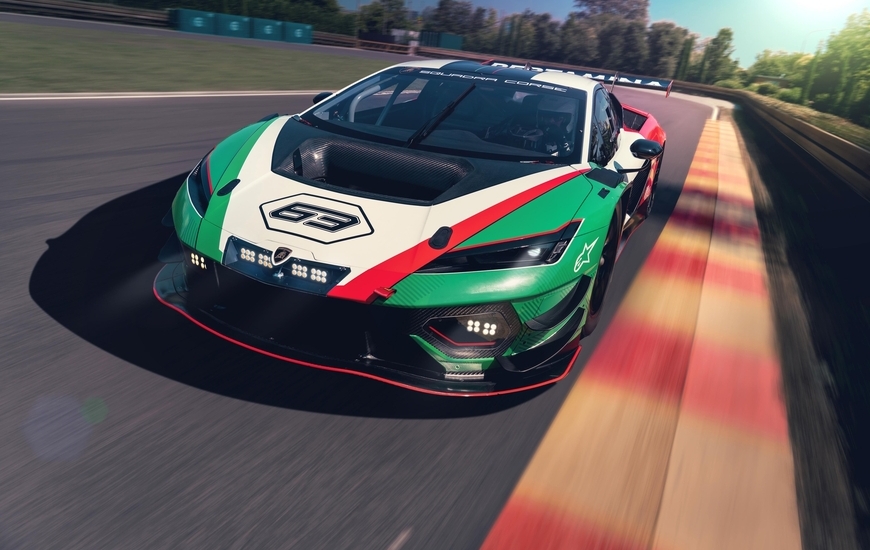Lamborghini has reaffirmed its commitment to international motorsport and today launches the new Temerario GT3, the very first race car derived from the Temerario road model. The Temerario GT3, which will compete in race series around the world, sets a new standard for the company’s competition cars and is the first to be entirely designed, developed and built at the Sant’Agata Bolognese factory in Italy. Conceived from the outset with a motorsport derivative in mind, the Temerario project has allowed for strategic integration of race-oriented engineering from the earliest design stages.
As a result of this innovative approach by Lamborghini, the GT3 features an adapted version of the aluminum spaceframe chassis, specifically modified to meet the structural and serviceability requirements of racing. It is powered by the same 4-liter V8 twin-turbo engine as the Temerario production model, which has been re-engineered specifically in the area of forced induction, with redesigned turbocharging components to comply with GT3 regulations and deliver peak performance under race conditions.
“The Temerario GT3 is the first racing derivative of the Temerario project, further emphasizing Lamborghini’s strong commitment to motorsport as a key tool for promoting our brand,” stated Stephan Winkelmann, Lamborghini Chairman and CEO. “Following the sporting and commercial success of the Huracán GT3 project, with which we won 96 championships and sold over 200 units, we have always envisioned racing derivatives from the very inception of the Temerario project. The Temerario GT3 will set a benchmark for its competitors, just as the road-going Temerario has.”
“The Temerario GT3 has been designed with the end user in mind,” said Lamborghini Chief Technical Officer, Rouven Mohr. “Everything has been considered, from the efficiency of the aerodynamics to the power curve to the way in which the team is able to operate the car. The car operates in a slightly different area of the performance windows, that are used to balance the cars of different configuration, compared to its predecessor. We are confident that it will be competitive in terms of lap time, while also rewarding to drive in a wide range of conditions, including at night and in the rain. The development team has worked hard to ensure the car has a wide operating window, and that the teams are better able to work on it.”
All aspects of the Temerario GT3 have been carefully optimized for competition while the design team has also retained the essence of the production car. The project draws on the experience of Lamborghini’s motorsport department with the Huracán GT3, which has achieved 96 titles worldwide in GT3 competitions over the past ten years.
The aluminum spaceframe has been taken from the Temerario production line and converted for racing use through extensive lightweighting and simplification. In particular, the frame has been simplified to allow for quick removal and reattachment of the front and rear subframes during trackside operations. The removable rear subframe has been specially developed by Squadra Corse to accommodate the components of the engine and the new transmission, while all unnecessary brackets, which in the production car support the hybrid components, have been removed as they are not present in this racing version. In the central part of the aluminum frame a roll cage has been integrated, complying with FIA GT3 safety standards. The front subframe has also been modified, with removal of the electric motors that characterize the production car.
Mounted on the chassis is new bodywork made from carbon composite material for the first time, to reduce the base weight of the car as far as possible. The bodywork is the result of a collaborative effort between the aerodynamics team at Squadra Corse and the Lamborghini Centro Stile. The aim was to maintain the production car's unmistakable style while adapting it to the requirements of the new engine and brake cooling system, achieving the desired performance targets for downforce and drag to ensure optimal aerodynamic balance.
Additionally, the bodywork has been engineered for quick disassembly and reassembly during race weekends, to reduce time on pit road in case of repair. The front and rear ends of the bodywork are each constructed from a single piece. The rear diffuser, engine cover and bonnet have also been designed for rapid removal. Even the front lights feature a quick connector system for quick disassembly. The floor comes in four separate parts including two sections ahead of the front axle - one through the center of the car - and a powerful rear diffuser. The center section has been designed so that it can, if necessary, be changed while the car is on its air jacks in the pit lane.
The refuelling system has been updated to increase the flow rate into the tank, while the tank design has been changed, enabling a new fuel sensor to be used to provide more accurate readings to the team. The aerodynamics have been optimized to improve the stability of the car under braking and reduce balance shift through cornering. With temperature management in mind, airflow to the radiators has also been improved as has the front radiator design, with efficiency of paramount importance. The removal of the hybrid unit from the engine has in turn increased demand on the turbochargers, which require greater airflow to maintain control of their temperature.
-

-
11 July 2025






















